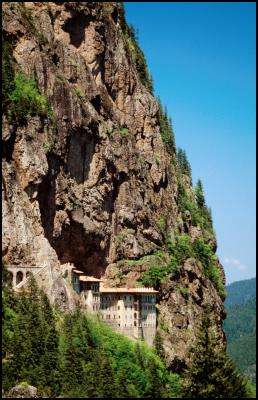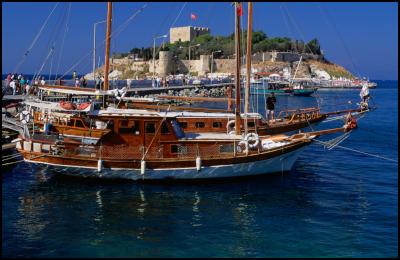Gallipoli pilgrims encouraged but not on ANZAC Day
Lonely Planet encourages Gallipoli pilgrims – but not
on ANZAC Day
There’s a long tradition of travellers
calling Lonely Planet guidebooks their “bible”. In
uncertain times like now, it’s natural for people to turn
“back to the bible” - to a trusted voice that will
provide answers and add value to their trip.
To coincide with ANZAC Day and the flocks of Australians that make the pilgrimage to Gallipoli, Lonely Planet launches its new edition Turkey guidebook on Monday 6 April 2009. However, as the guidebook details, by exploring the country’s 780,000 sq km, travellers are sure to develop their own favourite Turkish experience from this fascinating country.

What has become a rite of passage for young Australians with 12,000 visitors attending last year’s ANZAC Day memorial at ANZAC Cove, the numbers of domestic visitors have also grown by leaps and bounds with Turkish official sources reporting visitors numbered two million in 2007, up from between 400,000 and 500,000 five years before.
This increased popularity has made site conservation of the national park particularly challenging to the point, as the guidebook describes, of ‘overwhelming the peninsula’s modest infrastructure.’ The book highlights the fact it is easier to ‘appreciate Gallipoli’s poignancy and beauty at almost any other time,’ suggesting the ‘only way to save Gallipoli is to do the `unpatriotic’ thing and stay away, at least on 25 April.’
Instead, the Turkey guidebook opens up endless options for what to do in the country, whether it is used as a perfect accompaniment to an ANZAC Day journey to Gallipoli or as a guide for those wanting to experience the sights, sounds and sensations that Turkey has to offer.

‘Connecting western Europe and the Balkans to central Asia and the Middle East, Turkey has been a kingpin in Eurasian history,’ the guidebook explains. ‘There’s Turkish cuisine (did someone mention kebaps?), Mediterranean and Aegean beaches, Istanbul’s minaret-punctured skyline, and exotic bazaars and hamams (Turkish baths).’
The Turkey guide highlights that ‘the home of Troy and Ephesus boasts more Greek and Roman ruins than Greece and Italy.’ These historical drawcards contrast with the country as a ‘place to get stuck into activities ranging from kayaking over an underwater city to watching dervishes whirl,’ as well as tan chasers ‘swimming in options when deciding where to recline by the wine-dark sea.’
There’s a huge restoration and revitalisation program underway to mark the fact that Istanbul is one of the European Capitals of Culture in 2010. Author Virginia Maxwell highlights the current ‘sense of energy, innovation and optimism’ in this extraordinary city.

‘The contemporary art scene here is one of the best in the world. The Biennale is building an international reputation to match that of the annual International Istanbul Music Festival,’ explains Maxwell. ‘ Despite being a Muslim country, the city’s bar scene is booming. The Asian suburb of Kadikoy is super trendy. In particularly, the thriving grunge culture, trendy residential enclave, fab produce market and the stadium of the Fenerbahce football team.’
Other highlights of the guidebook include increased information on Turkey’s Cappadocia. Recommendations include ‘gazing at the pigeon houses riddling cliffs and fairy chimneys in Goreme’s labyrinthine valleys.’ In the east of the country the ‘Palace of Ishak Pasha in Dogubeyazit’ and the ‘photogenic stone statues of Nemrut Dagi’ are off the beaten track suggestions. On the coast, Patara comes highly recommended boasting ‘the country’s longest (20km+) beach,’ and ‘the most extensive ruins in the Mediterranean.’
-Ends-


 Cross Street Music Festival: First Artists Announced For 2025 Cross Street Music Festival
Cross Street Music Festival: First Artists Announced For 2025 Cross Street Music Festival Bowls New Zealand: Lawson And Grantham Qualify To Keep Bowls Three-Peat Hopes Alive
Bowls New Zealand: Lawson And Grantham Qualify To Keep Bowls Three-Peat Hopes Alive Te Whatu Ora Health NZ: Health Warning – Unsafe Recreational Water Quality At South Bay And Peketā Beaches And Kahutara River Upstream Of SH1
Te Whatu Ora Health NZ: Health Warning – Unsafe Recreational Water Quality At South Bay And Peketā Beaches And Kahutara River Upstream Of SH1 Wikimedia Aotearoa NZ: Wikipedian At Large Sets Sights On Banks Peninsula
Wikimedia Aotearoa NZ: Wikipedian At Large Sets Sights On Banks Peninsula Water Safety New Zealand: Don’t Drink And Dive
Water Safety New Zealand: Don’t Drink And Dive NZ Olympic Committee: Lydia Ko Awarded Lonsdale Cup For 2024
NZ Olympic Committee: Lydia Ko Awarded Lonsdale Cup For 2024